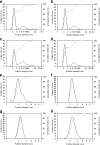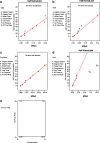Isoxyl aerosols for tuberculosis treatment: preparation and characterization of particles
- PMID: 20339959
- PMCID: PMC2902329
- DOI: 10.1208/s12249-010-9415-y
Isoxyl aerosols for tuberculosis treatment: preparation and characterization of particles
Abstract
Isoxyl is a potent antituberculosis drug effective in treating various multidrug-resistant strains in the absence of known side effects. Isoxyl has been used exclusively, but infrequently, via the oral route and has exhibited very poor and highly variable bioavailability due to its sparing solubility in water. These properties resulted in failure of some clinical trials and, consequently, isoxyl's use has been limited. Delivery of isoxyl to the lungs, a major site of Mycobacterium tuberculosis infection, is an attractive alternative route of administration that may rescue this abandoned drug for a disease that urgently requires new therapies. Particles for pulmonary delivery were prepared by antisolvent precipitation. Nanofibers with a width of 200 nm were obtained by injecting isoxyl solution in ethanol to water at a volume ratio of solvent to antisolvent of 1:5. Based on this preliminary result, a well-controlled method, involving nozzle mixing, was employed to prepare isoxyl particles. All the particles were 200 to 400 nm in width but had different lengths depending on properties of the solvents. However, generating these nanoparticles by simultaneous spray drying produced isoxyl microparticles (Feret's diameter, 1.19-1.77 microm) with no discernible nanoparticle substructure. The bulking agent, mannitol, helped to prevent these nanoparticles from agglomeration during process and resulted in nanoparticle aggregates in micron-sized superstructures. Future studies will focus on understanding difference of these isoxyl microparticles and nanoparticles/nanoparticle aggregates in terms of in vivo disposition and efficacy.
Figures







Similar articles
-
Isoxyl particles for pulmonary delivery: In vitro cytotoxicity and potency.Int J Pharm. 2010 Aug 30;396(1-2):99-104. doi: 10.1016/j.ijpharm.2010.06.037. Epub 2010 Jun 25. Int J Pharm. 2010. PMID: 20600722
-
One-step preparation of rifampicin/poly(lactic-co-glycolic acid) nanoparticle-containing mannitol microspheres using a four-fluid nozzle spray drier for inhalation therapy of tuberculosis.J Control Release. 2009 Apr 2;135(1):19-24. doi: 10.1016/j.jconrel.2008.11.027. Epub 2008 Dec 7. J Control Release. 2009. PMID: 19121349
-
Development of Dried Emulsion/Mannitol Composite Microparticles through a Unique Spray Nozzle for Efficient Delivery of Hydrophilic Anti-tuberculosis Drug against Alveolar Macrophages.Biol Pharm Bull. 2019;42(11):1846-1853. doi: 10.1248/bpb.b19-00368. Biol Pharm Bull. 2019. PMID: 31685768
-
Preparation of polymeric submicron particle-containing microparticles using a 4-fluid nozzle spray drier.Pharm Res. 2006 Jan;23(1):177-83. doi: 10.1007/s11095-005-8718-2. Epub 2006 Nov 8. Pharm Res. 2006. PMID: 16267631
-
The role of particle physico-chemical properties in pulmonary drug delivery for tuberculosis therapy.J Microencapsul. 2014;31(8):785-95. doi: 10.3109/02652048.2014.932029. Epub 2014 Aug 4. J Microencapsul. 2014. PMID: 25090595 Review.
Cited by
-
A review of formulations and preclinical studies of inhaled rifampicin for its clinical translation.Drug Deliv Transl Res. 2023 May;13(5):1246-1271. doi: 10.1007/s13346-022-01238-y. Epub 2022 Sep 21. Drug Deliv Transl Res. 2023. PMID: 36131190 Free PMC article. Review.
-
Mouse model for efficacy testing of antituberculosis agents via intrapulmonary delivery.Antimicrob Agents Chemother. 2012 Jul;56(7):3957-9. doi: 10.1128/AAC.00464-12. Epub 2012 Apr 30. Antimicrob Agents Chemother. 2012. PMID: 22547626 Free PMC article.
-
A systematic in silico search for target similarity identifies several approved drugs with potential activity against the Plasmodium falciparum apicoplast.PLoS One. 2013;8(3):e59288. doi: 10.1371/journal.pone.0059288. Epub 2013 Mar 26. PLoS One. 2013. PMID: 23555651 Free PMC article.
-
Importance of the genetic diversity within the Mycobacterium tuberculosis complex for the development of novel antibiotics and diagnostic tests of drug resistance.Antimicrob Agents Chemother. 2012 Dec;56(12):6080-7. doi: 10.1128/AAC.01641-12. Epub 2012 Sep 24. Antimicrob Agents Chemother. 2012. PMID: 23006760 Free PMC article. Review.
References
-
- WHO. World Health Organization report: global tuberculosis control—epidemiology, strategy, financing. Geneva: WHO; 2009.
MeSH terms
Substances
LinkOut - more resources
Full Text Sources
Other Literature Sources
Medical

